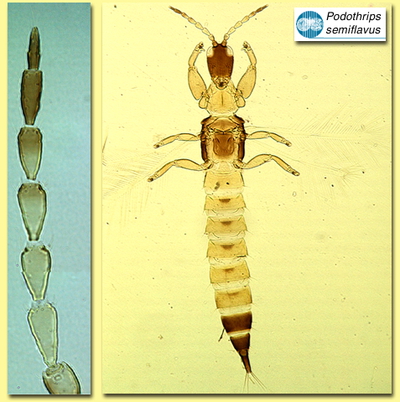Figures
Fig. 1 Antenna, head, thorax and abdomen
Fig. 2 Head and fore tarsus
Fig. 3 Pronotum
Fig. 4 Prosternal plates
Fig. 5 Fore and hind wing
Fig. 6 Tergite IV with wing retaining setae
Species
Podothrips semiflavus HoodBiology
Predatory on Coccoidea living on various Gramineae, including sugar cane.
Distribution
Widespread in tropics and sub-tropics.
Recognition
Body bicoloured, head, pterothrorax and abdominal segments VIII-X brown, but pronotum, legs, antennal segments III-VII, and abdominal segments II-VII yellow; wings pale. Head longer than wide, stylets about one third of head width apart, maxillary bridge well developed; postocular setae almost acute. Antennae 8-segmented, III & IV each with 2 simple sense cones. Pronotum with anteromarginal and midlateral setae minute, anteroangular setae with apex capitate; prosternal basantra longer than wide with median margins closely parallel. Fore tibia with a tubercle at inner apex; fore tarsus with pronounced tooth. Metanotum scarcely sculptured medially. Forewings weakly constricted medially, with no duplicated cilia; sub-basal setae B1 & B2 capitate, B3 acute. Pelta slightly longer than wide; tergites each with 2 pairs of sigmoid wing-retaining setae; tergite IX B1 setae acute and longer than tube.
Related species
Although this is a distinctive member of the genus with the pronotum yellow in contrast to the brown head, there is at least one similar species in northern Australia and New Guinea. However that species, P. moundi, has abdominal tergite VII brown.







